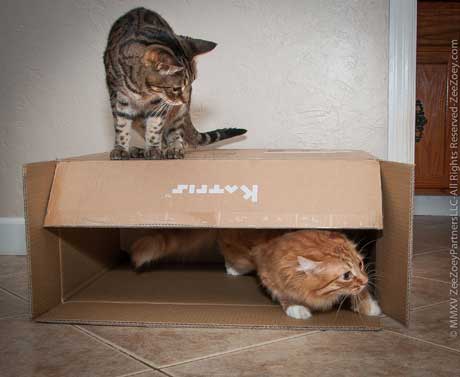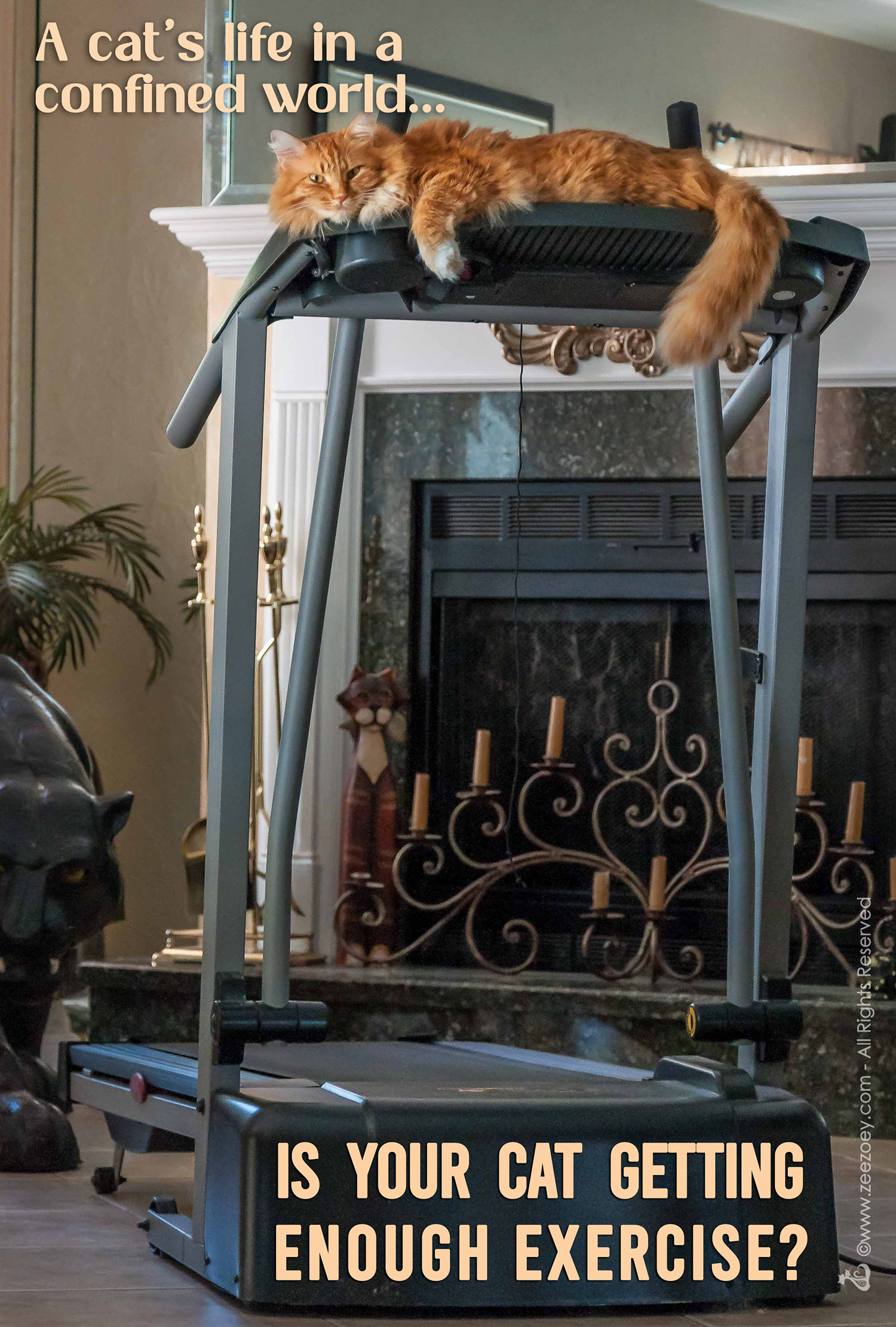Ten Healthy Playtime Tips and Exercises for Your Cat in a Sedentary Environment
 I’ve been working remotely from home on and off since March 2020 when the World Health Organization declared COVID-19 a pandemic and President Donald J. Trump declared a nationwide emergency. I actually prefer it – I’m highly efficient in a home environment, I don’t need supervision, I don’t have to worry about commuting, I don’t have to stress over health issues associated with my eyesight, and I’m grateful for any extra time I’m able to spend with my cats who are also thrilled when I’m home all day.
I’ve been working remotely from home on and off since March 2020 when the World Health Organization declared COVID-19 a pandemic and President Donald J. Trump declared a nationwide emergency. I actually prefer it – I’m highly efficient in a home environment, I don’t need supervision, I don’t have to worry about commuting, I don’t have to stress over health issues associated with my eyesight, and I’m grateful for any extra time I’m able to spend with my cats who are also thrilled when I’m home all day.
Last week, I got the news I’ll be working permanently from home. While I’m happy about the change it doesn’t come without challenges. One of them being my physical fitness because if I don’t make a conscious effort to step away from my computer for some exercise, I could be sitting for hours on end without a break. Not healthy. Now, imagine your indoor cat – in a sense, they have always been working remotely, trapped in whatever four-wall environment we have created for them, and their need for exercise is equally important. As guardians of our pets, it’s up to us to provide them with the exercise and stimulation they need to keep their bodies fit and their minds sharp because the fact is, a sedentary lifestyle is unhealthy for us and it is unhealthy for a cat, too.
The Cornell Feline Health Center estimates more than 50 percent of cats seen at veterinary clinics are overweight, if not obese.* Obesity-related health problems include heart disease, ruptured ligaments, respiratory compromise, tiredness, diabetes, greater susceptibility to certain types of liver disease, and osteoarthritis. Cats typically get fat because they eat too much and exercise too little – conditions we have to help our pets manage.
Before doing anything, however, whether a change in diet or exercise routine, Dr. Lynn Bahr, feline veterinarian and CEO of Dezi & Roo, a company devoted to making cat toys designed to look, feel, sound, and smell like wildlife to appeal to cats’ natural instincts, says to consult with your veterinarian as sudden changes in your cat’s diet or exercise routine could be unsafe. Much will depend on the age and health of the cat, too. A senior cat, for example, may no longer be able to engage in rigorous play sessions or jump to their favorite spot, but they still need exercise and your veterinarian can help you determine what types of play are safest for them.
Once you’ve established the best strategy for your cat, there are numerous activities you can incorporate into a daily routine with them. Not only is it good for them physically, but it will relieve the mental stresses and boredom of their everyday environment and it’s a great opportunity to strengthen your feline-human bond. Looking for ideas? Here are 10 quick tips on how to incorporate playtime and exercise into your cat’s routine:
1. Put an empty box on the floor. There are very few cats that aren’t tempted by the lure of a box and it will allow them to get up from a nap to investigate things.

Don’t throw that empty box away! Bring it out on occasion for a fun game of hide and seek!
2. Switch things up. Put a chair or pillow under a window for a change of pace or move a piece of furniture around. Cats like finding new areas to explore and something simple like this is a quick trick.
3. Make treat time both a physical act and an act of cunning, rather than just giving your cat a treat. Tuck treats in spots for your cat to sniff out or buy a cat treat puzzle so your cat has to figure out how to get the treat out before he can be rewarded for his hunting skills. Puzzle toys are easy to make too. Award-winning author, Angie Bailey, shares an article in Catster with some great DIY cat toys and puzzles – all made with empty toilet paper rolls!

Our senior cat, Zee, loves to find treats hidden in this simple puzzle I made by poking holes in a box.
4. Take an old toy (or get a new one) and dust it with catnip. Either hide it for your cat to find or toss it around for your cat to chase after. Cats love to simulate the hide/hunt/stalk/kill instinct and many will thank you by “killing” a toy and bring it to you as a gift. Experiment, too. If your cat doesn’t like a particular toy, Dr. Bahr recommends you don’t give up, but rather, you “think like a cat” and engage from their perspective. She says, “Think about how real prey would move – unless your cat enjoys it, don’t whip a toy around frantically. Instead, fly like a bug, slither like a snake, flutter like a bird, and rustle noisy toys like a chipmunk. Keep trying different techniques until you find one your cat can’t resist.”

Not all cats do it, but many of them enjoy a game of toss and fetch or will bring you a toy they have “killed.”
5. If weather permits and you have screens, open a window so your cat gets a whiff of some fresh air and new smells. Nothing helps stimulate a cat’s predatory mind more than the potential opportunity to spot birds, lizards, squirrels, bugs, and more. Just make sure the screens are tightly secured, with no tears that could allow your cat to accidentally get outside. And if you live in an area where you feel it is safe and your cat is up for it, consider taking her outside for a walk in either a leash/harness or a specially designed cat stroller that she can sit in to watch the world.

Opening the blinds to reveal a squirrel outside – an ordinary day becomes exquisitely extraordinary for a cat.
6. Crinkle up a piece of paper or foil and throw it on the floor so kitty can play a game of “hockey.” You’d be surprised at how much fun that simple act can provide a cat and it’s quick, easy, and inexpensive! Another quick and easy trick to get their motor running is to close a door. With you on one side and the cat on the other, take a string, feather, stick, or whatever and poke it under the door for your cat to pounce on!
7. Provide your cat with lots of shelves, cat trees, cat condos, and more to give them the freedom of jumping up to high places. Not only does this give them exercise, but it’s also an important part of their instinctual need to claim territorial ownership of vertical space for perching, hiding, and pouncing on prey.

A cat tree is important to the everyday environment of a cat. It’s a place to perch, hide, nap, and claim territory. This beautifully hand-crafted tree is from Pet Tree Houses of DeBary, Florida.
8. As long as there is nothing dangerous in the room, consider opening a door that is normally closed, such as a closet or guest bedroom. Something that is typically off-limits to a cat is quite exciting to explore when given the opportunity.
9. Make sure your cat has plenty of scratching options. Cats are born with claws for a reason and providing them with safe outlets to scratch is important to their health and well-being. Scratching allows them to stretch and flex their body to work off energy as well as to sharpen and remove the dead outer layer of their claws.

Having several cat scratchers available to your cat not only provides healthy exercise, but it’s also good for your cat’s claws.
10. Consider purchasing a small motorized furry toy, such as a fake mouse to get your cat’s attention. Wand toys are also great, especially feather toys that mimic the movement of a bird, one of a cat’s favorite objects for stalking (just keep in mind your cat should never have access to feather toys without supervision, as they can be dangerous if ingested).
These are just a few of the many things you can do to help keep your cat in tip-top mental and physical health. A well-exercised cat is more likely to be a happy and content cat, and given that our cats can live upwards of 15 years, it’s up to us to provide them with the proper environment, diet, and stimulation to do so.
*While a trusted veterinarian can give you the best inclination as to whether or not your cat is overweight, please visit the article “Obesity in Cats” as published in VetStreet.com for a general overview.


























We enjoy all of those, and I’m sharing your post so others can, too.
I’ve worked at/from home for yonks and I designed a 40-minute workout that I do 4-5 times a week. One weight bench and some weights are all I’ve had to buy. No special mats, clothes, or machines. After work each day, I hit the bench.
Great tips. I need to do these for my cats as some are as lazy I am. 🙂
these are GREAT ideas and thank COD (since I am so lax about playing with Roary one-on-one, yes I am awful!) I do a lot of these things! He has 3 cat trees, numerous toys, empty boxes, yesterday I cut the handles off of a Whole Foods paper bag and threw it on the floor and he had a field day. I do crinkle up paper. He has 2 giant windows to watch birds…….and of course he has Levi who he spends time running AWAY from lol